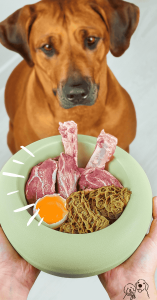
Let’s chat about something that’s been buzzing around in the doggy nutrition world: the raw food diet for dogs. Now before you picture your pooch gnawing on a T-bone steak every night (though wouldn’t they just love that?), let’s break it down.
The idea behind a raw food diet is pretty simple—feeding our furry friends what their ancestors might have eaten out in the wild. Think fresh meats, bones, veggies… all-natural stuff! It’s kinda like taking your dog back to their roots, letting them chow down on wholesome goodness that Mother Nature intended.
Now here’s where it gets interesting: many folks who’ve switched to this natural dog diet swear by its benefits. We’re talking shinier coats, more energy (as if they needed more zoomies!), and even better dental health—because those bones aren’t just for chewing; they’re nature’s toothbrush! Plus, when you focus on raw food benefits like these, you’re setting up your pup for long-term health wins.
Of course, as with anything new in our fur babies’ lives, it’s important to do some homework first. Every doggo is unique—I mean look at Max with his sensitive tummy or Mantou with his gourmet tastes! So if you’re considering this path toward healthier dogs through improved dog nutrition, chatting with your vet can be a great first step.
At the end of the day (or should I say “at dinner time”?), we all want what’s best for our four-legged family members—and sometimes that means exploring new avenues like a raw food diet for dogs.
Getting Started: What Exactly is a Raw Food Diet for Dogs?
A raw food diet is exactly what it sounds like—uncooked goodness fit for your furry carnivore. Imagine serving up meals that would make even Mantou’s nose twitch with interest!
So, you’ve heard about this whole raw diet for dogs thing and you’re curious, huh? Well, pull up a chair and let’s chat about it! Imagine a world where your pup’s meals are as fresh and natural as they come—sounds pretty great, right? That’s what the raw diet is all about.
A raw food diet for dogs consists of uncooked meats, bones, organs, and vegetables that mimic their ancestral diet.
When we talk about raw dog food basics, we’re diving into a menu that would make any dog drool: think uncooked meats, bones (yes, bones!), fruits, veggies, and even some organs. It’s like taking your fur baby back to their roots when wild ancestors roamed free and hunted for dinner.
Now before you start picturing your pooch chasing down prey in the backyard (yikes!), let me reassure you—raw feeding doesn’t mean letting them fend for themselves. Nope! It means carefully selecting wholesome ingredients that mimic what they’d naturally chow down on in the wild. And don’t worry if this sounds a bit daunting; there are plenty of raw feeding guides out there to help you get started without losing your mind.
A big question I often hear is “What can dogs eat raw?” Well, my friend Mantou can’t get enough of his beef liver treats. It’s all about finding what works best for your pup’s palate and tummy.
Remember though—not every dog will take to it like a duck to water. Transitioning to a new diet takes time and patience—but hey, isn’t that part of the joy of being a pet parent? Watching them thrive on something you know is good for them… now that’s priceless!
The Benefits (and a Few Challenges) of Feeding Raw
I won’t sugarcoat it—switching to a raw diet can come with its own set of challenges. If you’re like me, you’ve probably spent countless hours pondering over what’s best for your furry companion. I mean, we all want our dogs to thrive, right? So when it comes to feeding raw pet food—think raw meat for dogs and all that jazz—there are definitely some juicy bits (pun intended) to chew over.
First off, let’s talk about the perks. One of the biggies is that a raw diet can offer balanced nutrition for dogs. Imagine this: your pup chomping down on fresh meat, bones, and organs just like their ancestors did. It’s like serving up a five-star meal every day! Many dog owners find that their pets have shinier coats, healthier skin, and better dental health on a raw diet. And who doesn’t love seeing their canine buddy with a Hollywood-worthy smile?
A raw diet can improve coat health, energy, and dental health, but it requires careful planning and poses risks like bacteria and nutrient imbalances.
But hey, before we get carried away with visions of wolf-like feasts in our kitchens, let’s chat about some potential risks of raw feeding too. It can be tricky ensuring your dog gets all the nutrients they need without overdoing it on certain elements (calcium overload from bones is no joke!). Plus, there’s always the concern about bacteria in raw meat which could pose risks to both your dog and any humans sharing their space.
So what’s the takeaway here? Feeding raw can be incredibly rewarding but does require a bit more homework—and maybe some extra cleaning supplies! If you’re considering this path for your pup’s diet journey, it’s worth consulting with a vet or pet nutritionist to make sure you’ve got everything covered.
How to Transition Your Dog to a Raw Food Diet Safely
Since you keep reading this blog and are interested in learning more about the raw meat diet for dogs, you might be wondering how to switch your furry friend to it.
Transitioning dogs to raw food can feel like a big leap, but it’s not as daunting as it seems. The key is to introduce the new diet gradually. You might want to start by mixing small amounts of raw meat with their usual food and slowly increasing it over time. Keep an eye on how they react; every dog is unique in how they adjust. Plus, it’s a great way to bond with your pet during mealtime as you experiment together with different flavors and textures. Before long, you’ll notice that spark in their eyes—because let’s face it—who wouldn’t be thrilled at the sight of deliciously fresh meat?
Transitioning to a raw diet should be gradual, observing your dog’s reaction to the new food.
Remember, every dog is unique and might react differently during this transition phase. Keep an eye on their stools (I know, not glamorous but important!) and energy levels as you go along.
Switching your pup’s diet is an adventure—and trust me—seeing them thrive on fresh food makes every step worth it!
The Do’s and Don’ts: Common Mistakes When Starting Out on Raw Feeding

Jumping into raw feeding can feel like diving headfirst into a pool of excitement and, let’s be honest, a bit of anxiety too. It’s like you’re trying to become the Gordon Ramsay of dog cuisine overnight!
First up on our list of do’s: start slow. Think of it as introducing your pup to fine dining—one delicious course at a time. Begin with simple proteins like chicken or turkey before you get fancy with duck or venison. And remember, patience is key here; their tummies need time to adjust!
Now for the don’ts: steer clear of bones that are cooked or too small—they can be dangerous for your pooch! Stick to raw meaty bones that are big enough not to become choking hazards—especially if you’re feeding big dog raw food.
For those adorable little bundles of energy (aka puppies), raw puppy food needs extra care. Their growing bodies crave balanced nutrition—think calcium and phosphorus in perfect harmony! So don’t skimp on research when planning their meals.
And lastly, always keep an eye out for what not to feed dogs in their diet. Grapes? Nope! Chocolate? A big no-no! You’d be surprised how many human treats are off-limits for our furry pals.
Remember, every meal is a step towards healthier living for your pooches—and fewer vet visits mean more playtime adventures together!
Start slow, avoid cooked or small bones, and ensure balanced nutrition, especially for puppies, while steering clear of harmful foods like chocolate and grapes.
Embracing the Wag-Worthy World of Raw Eating
Alright, dog lovers, we’ve reached the tail end of our journey into the wag-worthy world of raw eating—pun totally intended! If you’ve stuck with me this far, I reckon you’re just as passionate about your pup’s health as I am.
I’m not saying it’s all sunshine and rainbows right off the bat. Transitioning to raw can be a bit of a rollercoaster ride. But hey, isn’t that part of the fun? You get to play detective and figure out what makes your pup’s taste buds sing (and their tails wag like crazy). Plus, there’s something pretty awesome about knowing you’re doing everything you can for their health.
So why not give it a go? Who knows—you might just end up feeling like super-dog parent numero uno! And let’s be honest—our four-legged companions deserve nothing less than our best efforts.


